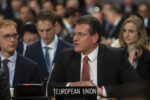Is it a coincidence that Russia’s Rosatom is back in the headlines a few days before the biggest economic event in Poland? Poles want a final decision on a nuclear power plant. Russians are building a lot of those. However, it turns out there are more arguments against Rosatom because of technical reasons, rather than security concerns – writes Wojciech Jakóbik, BiznesAlert.pl’s editor in chief.
Rosatom wants to build in Poland again
Before the Economic Forum in Krynica in 2016, Russia’s Rosatom invited the Polish media to conduct interviews with the company’s CEO. The response was not overwhelming. A similar situation took place when they were invited to take part in the ATOMEXPO conference in Moscow in June 2014. BiznesAlert.pl received both invitations. The Russian concern does not have good press in Poland because of the tense relations caused by Russia’s illegal annexation of Crimea and aggression on eastern Ukraine. The Russian company has been impacted by the backlash of these events across Europe.
However, in 2017 the Polish government announced that the updated Polish Energy Policy by 2030 may include nuclear energy. Thus, it provoked a discussion on the future of the atom in Poland and potential financial and technological partners. While Poland is considering to self-finance the reactors and declares this is possible, the technology will have to come from abroad. Applicants from France, the USA, South Korea, Japan, China and… Russia got in line.
Since the discussion about a Polish nuclear power plant is back on the agenda, Rosatom-Atomenergopromsbyt General Director Dmitry Sukhanov gave an interview to the Polish version of the Kremlin-owned Sputnik, where he said “if Rosatom receives an invite to take part in the possible Polish tender for the construction of a nuclear power plant,” the company would consider participating in it and may offer the WWER technology, which is “one of the most safe reactors.” This is a repetition of a declaration made in December 2011 when in an interview for the Polish Rzeczpospolita daily the then CEO of Rosatom said that his company would definitely take part in the tender if took place.
In 2012 Poland’s nuclear power plant project did not kick off. It has been reported that the Ministry of Economy talked on replacing it with electricity imports from the Kaliningrad Oblast where by 2016 a new nuclear facility was supposed to have been constructed. Rosatom wanted to sell some of the power to Poland via an electricity interconnection, which was supposed to have been built by Poland’s PSE and Russia’s Inter RAO. This did not happen. It is hard to say whether the Russian offer had any impact on the lack of progress of the Polish nuclear project in the following years. However, it would be interesting to research the engagement in the idea to import power from Kaliningrad of the same staff who negotiated the criticized Yamal contract for gas deliveries from Russia.
Back then the integrated tender for the financing and technology of Poland’s nuclear power plant did not happen, today Poland’s Nuclear Energy Program is to be updated and a tender for technology only is to be announced. Everything depends on the financing, which will be determined in a separate procedure. The Polish government declared it was capable of financing the facility on its own, even though the Energy Minister Krzysztof Tchórzewski admitted it would be expensive. The government dispute on the atom’s place in the energy mix has not ended yet. The supporters of coal at the Energy Ministry and supporters of geothermal energy at the Ministry of Environment do not want it.
In the face of these problems one could ponder on Rosatom’s participation in the Polish nuclear project. If it wasn’t for the stigma of Russia’s illegal actions in Ukraine and its support for the regimes in Syria and North Korea, it could seem like an attractive perspective. One could argue that after the possible normalization of relations with Russia, it would be possible to create partnership-like relations with Rosatom and arrange for a beneficial transfer of the WWER technology. However, it turns out that this would be a dangerous turn of events even if it was possible to ensure security against unwelcome Russian influence.
Power plant like an embassy
Perhaps companies from Asia and Russia will be the only ones with the financial potential to construct nuclear power plants in Europe. Such opinions could be heard during the annual Odessa Non-Proliferation School, which gathered experts who conduct research on the proliferation of nuclear weapons and technologies, including nuclear energy. Still, would that be a safe solution?
The Russians are building nuclear power plants in countries without strict regulatory control. Rosatom is currently building two out of six planned reactors in the nuclear power plant in Kudankulam in India, 1000 MW each. It is also constructing four 1200 MW reactors in Ninh Thuan nuclear power plant in Vietnam. The other projects include the second and third reactors in the Bushehr nuclear power plant 1000 MW each, it is also set to build four 1200 MW reactors in El Dabaa nuclear power plant in Egypt, one in Rooppur in India (2400 MW), two 1000 MW reactors in Amra power plant in Jordan. They are also constructing two 1200 MW reactors in the Ostrowiec nuclear power plant in Belarus, which will be described with more details below. In every case the Russians participate in costs. The same is with the Akkuyu power plant in Turkey where they will build four 1200 MW reactors.
According to Sebnem Udum, Deputy Director of the Center of Strategic Research of Hacettepe University in Turkey, who participated in the event in Odessa and who put under scrutiny the Akkuyu nuclear power plant, the project was dominated by Russians. “The Akkuyu nuclear power plant is like Russia’s nuclear embassy. The staff is trained in Russia, except for basic construction workers, all other activities are run by Russians. In result it will not be a Turkish power plant, but Russian,” she told BiznesAlert.pl.
So far the Russians did not manage to acquire a construction permit for a facility in the European Union. The expansion of the Paks nuclear power plant in Hungary can be an example here. It includes four WWER-440 units and covers 50 percent of energy demand in the country. At the end of 2014 Hungary signed an agreement with Russia to build two WWER-1200 units with EUR 10 bn borrowed from Russia. The European Commission assessed this did not go against the EU rules on public aid, but the Russians had to adjust the original contract to the Commission’s requirements. However, they have recently increased the loan to EUR 12 bn, which means they will finance the entire investment.
The preparatory works for the construction were supposed to start in the fall of 2017, but it remains unknown whether this will be possible if the EC questions the financing. Other problems may occur during the process of license acquisition when questions about specific technical solutions for securing the facility may be asked. The fact that Vladimir Putin announced yet another visit to Budapest where Pacs will be an important topic may show that there might be problems with the project. Perhaps this is why so far not a single spade hit the ground on the construction site.
In a piece for BiznesAlert.pl Dominik Hejj, PhD, wrote that the project will have an impact on the parliamentary elections in Hungary in 2018 when the construction will start. It will also acquire historical context if the first unit will be launched according to plan on 15 March 2026 on the Spring of Nations national holiday. Russians may use it to impact Hungary’s internal politics. Perhaps this is why they are ready to pay EUR 12 bn for the new blocks. Due to the concerns about Russian influence in Poland, the Polish government probably does not take into consideration Russia as its project’s technological partner.
Whereas Finland’s Hahnkivi project implemented together with Fennovoima is waiting for a construction license, but a meticulous inspection of the local regulator is now taking place. The facility is to start producing power in 2024. It would be the first case in history when a Russian WWER reactor has been built in the European Union. However, the Finns from the STUK agency asked for the highest standards and started the certification process of the materials used for the construction of the facility. Rosatom’s representatives admitted that they did not have such problems during the Soviet Union times when the Loviisa nuclear power plant was built.
The Finns insisted on redesigning the facility. The plans for the security system and the reactor’s coating were changed. The Finns also demanded that the work ergonomics in the facilities be changed by leaving more space between the equipment and widening the alleys, streamlining the ventilation and heating systems. In a space where the Russians install six emergency diesel generators, Finns wanted ten. The parties even took into consideration the seismic risk in Finland where earthquakes at 2-3 points in the Richter scale have occurred.
Falling reactors
According to one of the experts who participated in the Odessa Non-Proliferation Summer School 2017, Russians were not ready for such a careful assessment of documentation, decisions and procedures by the regulator’s specialists. European specialists would point out minor errors and inaccuracies, which would be ignored by regulatory agencies with a weaker position. Russia’s careless approach to projects outside of the European Union may be evidenced by an incident that occurred during the construction of the Ostrowiec nuclear power plant. The Russian construction crew dropped a reactor vessel during transportation. At first, Rosatom argued that it would not impact the safety of the operation of the power plant, but under international pressure, especially from Lithuania whose capital city is several kilometers away from the facility, the company caved in and provided a new reactor vessel. It would be impossible to accept such an approach in the European Union, especially after the nuclear disaster in Japan’s Fukushima, the European Commission’s stress tests and the newly introduced requirements for projects that have been already completed or are still in the design phase in the European Union.
The project in Ostrowiec could be a replacement for the failed power plant in Kaliningrad. The current Polish government is not interested in purchasing energy from either. The events in Ostrowiec and Russia’s problems in Hungary and Finland show that their participation should be considered carefully not only because of political reasons. There exist objective concerns that Rosatom could mess up Poland’s nuclear program and not finish it because of its inability to meet the strict European standards, or complete it with a delay, which would force Poland to bear additional costs.






